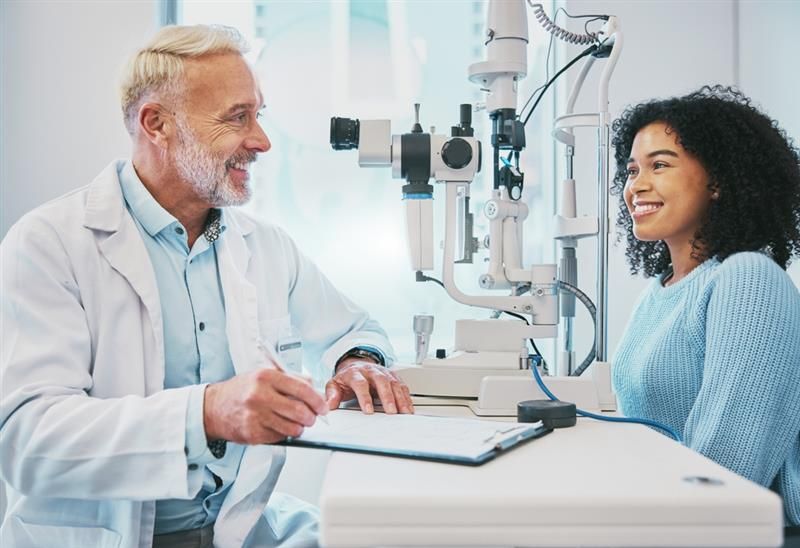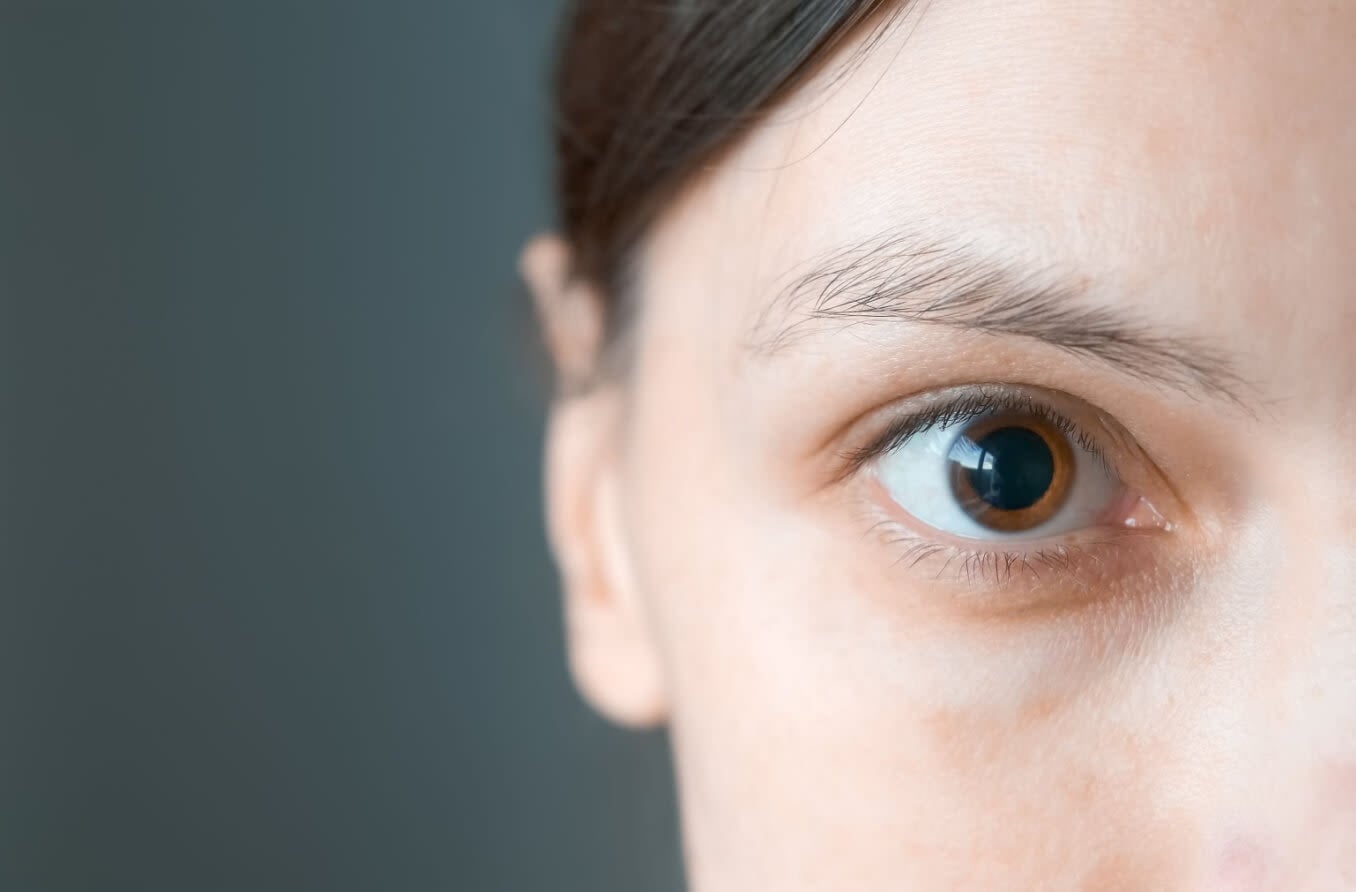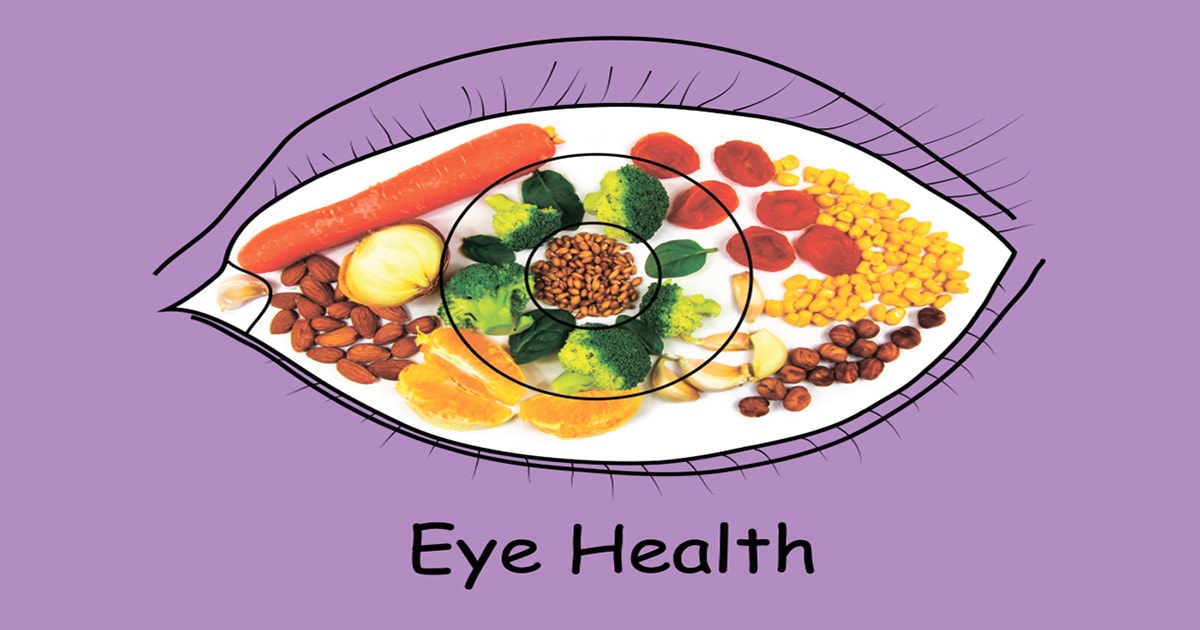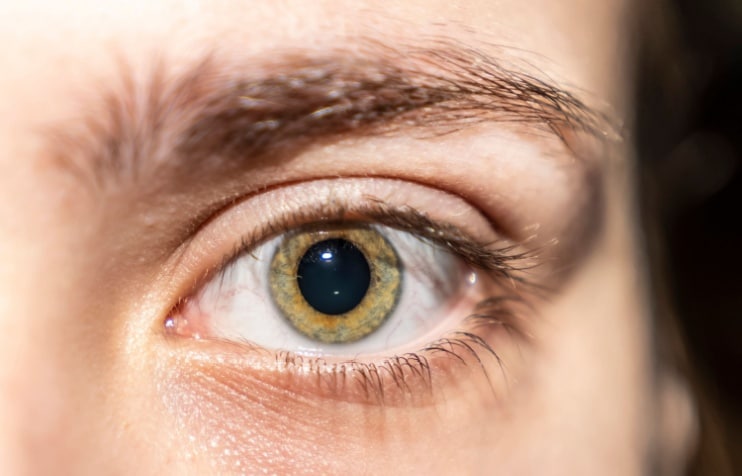How stimulants like Adderall can affect your eyes
Stimulant medications like Adderall are sometimes prescribed for people with attention deficit hyperactivity disorder (ADHD). They’re used to help improve concentration, complete tasks and reduce impulsiveness. However, these medications may cause eye- and vision-related side effects, including:
- Difficulty focusing at different distances
- Blurry vision
- Dry eyes
- Pupil dilation
Stimulants speed up communication between your brain and body, making you feel more focused, alert and energetic. You may also experience these effects after consuming over-the-counter stimulants like caffeine or nicotine.
ADHD stimulant medications can be formulated for immediate release (lasting up to 4 hours) or extended release (lasting as long as 16 hours). The two main types of stimulants prescribed for ADHD include:
- Amphetamines (like Adderall and Vyvanse)
- Methylphenidate (like Ritalin, Concerta and Focalin)
General side effects of these medications can include:
- Loss of appetite
- Interruptions in sleep
- Mood changes
These side effects may be mild and disappear on their own, or they may worsen over time. It’s important to speak to a doctor about any side effects so you can manage them effectively.
Common eye problems from stimulants
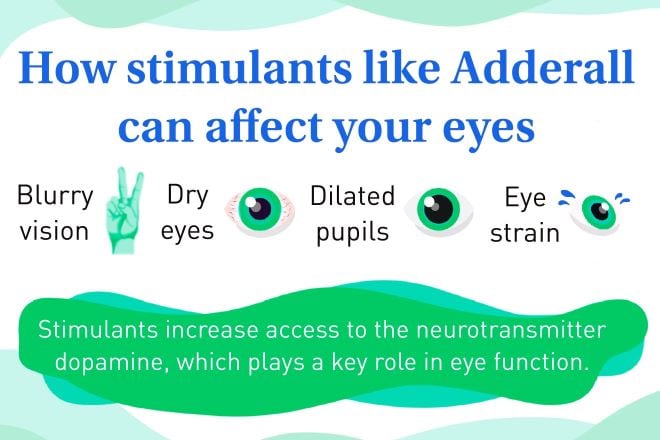
Stimulants like Adderall can have multiple effects on the eyes. Adderall and other ADHD medications typically work by increasing the brain’s access to dopamine. Dopamine is a neurotransmitter, a chemical that carries messages in the brain.
Dopamine is involved in motivation and reward-seeking behavior. It also plays a key role in eye functions, including:
- Contrast sensitivity
- Color perception
- Adaptation to changes in light
- Spatial processing (judging distances, perceiving depth)
- Temporal processing (perception of time in relation to visual stimuli and events)
The effects of stimulants on dopamine levels may affect these and other functions of the eye. This could lead to the following vision-related side effects:
Blurry vision
Over time, stimulants (especially methylphenidates like Ritalin) may affect the eyes’ ability to accommodate. Accommodation refers to your eyes’ ability to focus on objects at different distances. Problems with accommodation can make your vision seem blurry when shifting focus from a close object to a distant object or vice versa.
Blurry vision from stimulants may occur due to:
- The medications’ effects on neurotransmitters like dopamine and norepinephrine, which influence visual function.
- Reduced blinking associated with increased visual focus.
Some medications have anti-cholinergic properties that can affect several parts of the eye, including the ciliary muscle. The ciliary muscle changes the shape of the lens, which focuses light on the retina so you see nearby objects clearly. Anti-cholinergic drugs can make the ciliary muscle relax, which may lead to temporary blurred vision.
Longer-term treatment with a stimulant, like Ritalin or Adderall, could cause more blurry vision over time. Regular checkups are important to ensure side effects don’t worsen over time.
Dry eyes
If you’re taking a stimulant like Adderall, you may have dry eyes. They’re a common side effect of taking stimulants. With increased visual focus comes less blinking, limiting your natural tear distribution. This means your eyes are not getting lubricated as often as they normally would.
Dry eyes from stimulants like Adderall are often caused by reduced blinking. This may be due to increased visual focus, which limits natural tear distribution.
READ MORE: Dry eye treatment: How to soothe irritated eyes
Dilated pupils (mydriasis)
Your pupils naturally dilate (get bigger) or constrict (get smaller) in response to changes in light. They dilate when there’s less light, which allows you to see better. When pupils dilate regardless of changes in light, this is called mydriasis.
Your pupils may dilate on Adderall or other stimulants due to an increase in norepinephrine. This activates the sympathetic nervous system and relaxes the iris dilator muscle, possibly leading to mydriasis.
When your eyes are dilated, you may be more sensitive to bright lights. You may also experience a reduced “depth of field” with large pupils. This can make out-of-focus vision appear even blurrier.
Eye strain
By increasing concentration levels, stimulants increase the time your eyes spend focusing on your task. As a result of this extra focusing time, you may experience eye strain.
For example, if you spend a long time focusing on a book, phone screen or other nearby object, your eye’s natural lens will change shape. If you do this for too long, the muscles in your lens won’t have a chance to relax.
Eye strain can lead to:
- Headache
- Neck, shoulder or back pain
- Tired eyes
- Blurry vision or difficulty focusing your eyes
- Spasms in the eye and eyelid muscles
- Irritation (dry, burning or itchy eyes)
- Watery eyes
- Eye redness
- Sensitivity to light
- Heavy eyelids (making it hard to keep your eyelids open)
SEE RELATED: 10 tips for computer eye strain relief
Why stimulants change your vision
Stimulants speed up communication between your brain and body. They do this by increasing the availability of neurotransmitters like dopamine and norepinephrine.
Norepinephrine is a key neurotransmitter involved in the body’s fight-or-flight response. Increased norepinephrine can widen your pupils so you can see better in a stressful situation.
Dopamine plays a key role in eye functions and growth. Increased dopamine may also reduce neuronal noise (activity between neurons) in the retina. The retina is the layer of tissue in the back of the eye that senses and processes light. Reducing a heightened level of noise to a normal level may improve visual function.
When stimulants increase dopamine levels in the brain, it’s possible they also increase dopamine in the retina. However, the direct impact of stimulants on retinal dopamine and specific eye-related symptoms is not fully understood.
ADHD and vision
There is a possible connection between the development of ADHD and eye growth or function. Vision-related issues and conditions appear to happen more often in ADHD. Because the eye and brain develop from the same tissue, a neurodevelopmental condition like ADHD may also affect eye structures. Additionally, ADHD interferes with dopamine, which the retina relies on to function.
People with ADHD may have eye problems or symptoms before stimulant medication. The effect of stimulants like Adderall on pre-existing eye problems in ADHD is uncertain.
SEE RELATED: Vision problems can be misdiagnosed as ADHD or ADD
Risks & complications
Usually, taking a medically prescribed dose or substances like caffeine won’t result in strong, harmful effects. Serious complications are more likely to happen if the stimulant is used outside the prescribed dose or frequency. The severity of some effects will also depend on factors that vary from person to person, like body weight and medication tolerance.
Some problems, like blurry vision, may get worse with longer treatment, particularly with methylphenidate (Ritalin). If problems worsen or happen suddenly, you should see a doctor as soon as possible.
Stimulants and glaucoma
Stimulant medications like Adderall may increase eye pressure, also called intraocular pressure (IOP). Increased IOP is often associated with glaucoma, a group of diseases that damage the optic nerve and cause peripheral (side) vision loss.
People with a narrow drainage angle have an especially narrow passage for fluid to drain from the eye. This puts them at higher risk for increased IOP and certain types of glaucoma.
Widened pupils may also interfere with the eye’s ability to drain fluid, causing additional pressure to build up in the eye. This is because dilated pupils can push the iris forward, causing the angle to become limited or blocked. (The iris is the colored ring that surrounds the pupil.)
If the drainage angle becomes restricted, it can develop into narrow-angle glaucoma. If the angle becomes blocked, it may be diagnosed as closed-angle glaucoma.
Since Adderall may cause pupil dilation, its use may put someone with a narrow drainage angle at greater risk for narrow-angle or closed-angle glaucoma.
Acute angle-closure glaucoma
In extreme cases, the situation can quickly develop into acute angle-closure glaucoma. This is a medical emergency that may be characterized by:
- Intense eye pain
- Eye redness
- Sudden loss of vision
- Headache
- Nausea
- Vomiting
- Seeing rainbow-colored halos around lights
This type of glaucoma can come on fast. Vision can be lost as quickly as one day after the drainage angle suddenly becomes blocked. Again, acute angle-closure glaucoma is a medical emergency. See a doctor as soon as possible if you experience the symptoms above.
More research is needed
It’s important to stress that an association between stimulants and glaucoma has not been definitively proven. Some studies suggest a possible association between stimulant use and a slightly higher risk of developing certain types of glaucoma.
The best way to understand your level of risk for glaucoma is to see your eye doctor for a comprehensive eye exam. During the appointment, be sure to:
- Let them know if glaucoma or other eye conditions run in your family.
- Give them a list of any medications you take, including stimulants.
If you have narrow drainage angles or other risk factors for glaucoma and you also take stimulants, your eye doctor may recommend more frequent checkups.
Tips to help your eyes on stimulants
Although stimulants like Adderall may affect your eyes, there are several things you can do to counteract the side effects. The following treatments and lifestyle changes can help relieve dry eyes:
- Over-the-counter eye drops (sometimes called artificial tears)
- Wearing sunglasses outside
- Taking breaks from screens
- Using a humidifier and avoiding wind, air conditioning and smoke
- Blinking exercises (to make sure you aren’t going too long without blinking)
If you have dilated pupils while on Adderall or another stimulant, sunglasses will help protect your eyes from light sensitivity. And, dry eyes or not, it’s important to take screen breaks. This is also helpful if your eyes are blurry or you’re having trouble focusing. Other things you can do to prevent or relieve digital eye strain include:
- Make sure your screen is at or just below eye level, and keep it a little farther away than normal reading material
- Keep your screen clean and dust-free
- Adjust brightness with the lighting around you
- Use screen protectors and glasses (refractive glasses, not blue light glasses) to help minimize glare
To prevent any problems with accommodation, you can also start using the 20-20-20 rule while you work. Every 20 minutes, look at an object at least 20 feet away from you for at least 20 seconds. Since the ciliary muscle and the lens in your eye contract when looking at objects nearby, this gives those muscles a chance to relax.
These are just some of the things you can do to help treat side effects. It’s important to discuss any serious symptoms with a doctor. Additional treatment can be prescribed, or medication changes may be in order.
What to do if eye-related side effects worsen
Side effects will sometimes disappear in a few weeks after starting a medication. But if they don’t, you can always talk to your doctor about switching — they’ll help you find the right medication and dose.
Regular eye checkups are important to track and manage any symptoms. This is especially true if you are on a stimulant but have a higher-than-normal risk of glaucoma.
READ NEXT: Anti-anxiety medications & eye-related side effects
